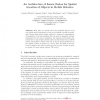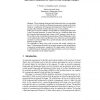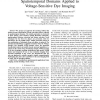11 search results - page 2 / 3 » From pixels to objects: Enabling a spatial model for humanoi... |
AROBOTS
2002
13 years 4 months ago
2002
If we are to build human-like robots that can interact naturally with people, our robots must know not only about the properties of objects but also the properties of animate agent...
EPIA
2005
Springer
13 years 9 months ago
2005
Springer
Each part of a mobile robot has particular aspects of its own, which must be integrated in order to successfully conclude a specific task. Among these parts, sensing enables to co...
IJCNN
2007
IEEE
13 years 10 months ago
2007
IEEE
Learning by human tutelage means that a human being guides the attention of a robot or agent in order to teach it a given concept. This kind of learning is very important to devel...
ECCV
2002
Springer
14 years 6 months ago
2002
Springer
When estimating foreground and background layers (or equivalently an alpha matte), it is often the case that pixel measurements contain mixed colours which are a combination of for...
ICDM
2009
IEEE
13 years 2 months ago
2009
IEEE
We present an approach for learning models that obtain accurate classification of large scale data objects, collected in spatiotemporal domains. The model generation is structured ...



